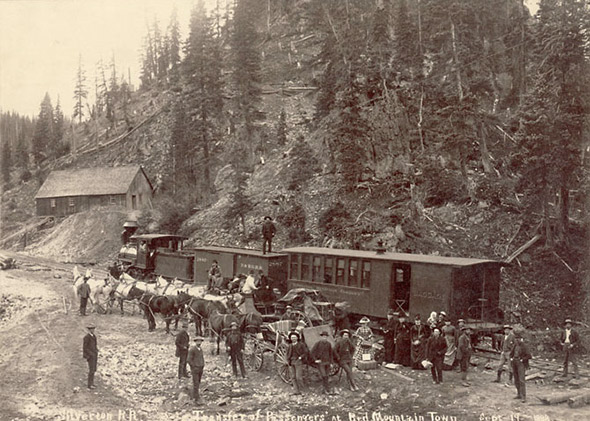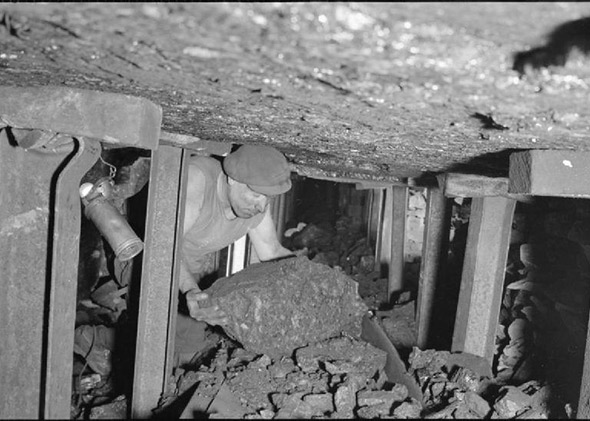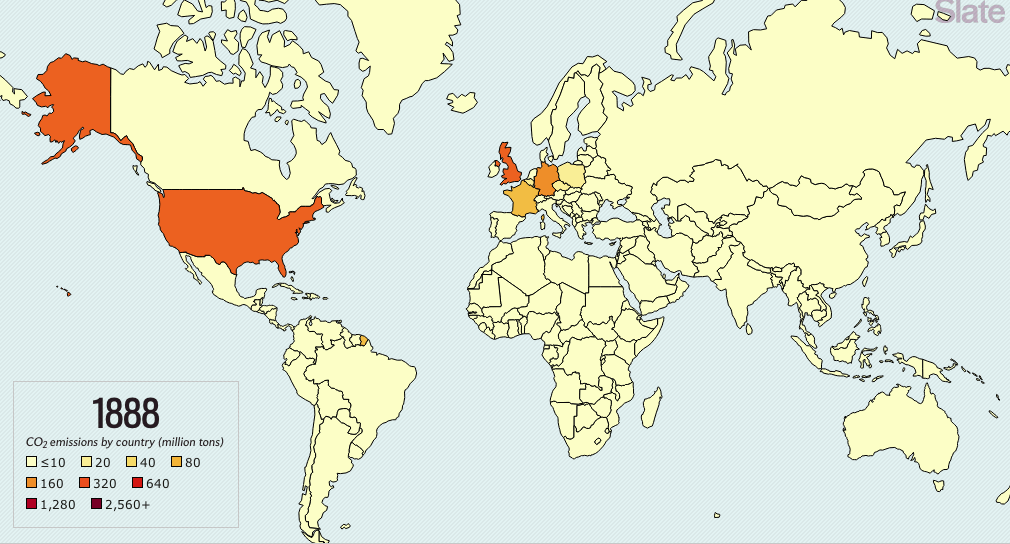A Filthy History
Interactive map: Which countries have emitted the most carbon since 1850?

To get a sense of how ridiculous carbon pollution has become, going back in time gives some perspective.
So, let’s time-travel.
The World Resources Institute just updated its compendium of historical carbon dioxide emissions for each country in the world to include 2011. More interestingly, the group has extended the oldest data. Previously the collection reached only to 1990, but now it goes all the way back to 1850.
The story of climate change is perhaps best told by exploring some key points in time to show how we got to where we are today.
England, 1850:
Jolly old England was really the only game in town. The Industrial Revolution began here and was still in its infancy. The coal mines were horrible in every sense of the word, and accidents were frequent. Social progress was epitomized by the Mines Act, passed in 1842: It banned underground employment for boys and girls under the age of 10. Somehow, 164 years after this point in history, coal is still one of the top energy sources on planet Earth.
But the amount of CO2 England was emitting was still tiny, about as much as comes from present-day Uzbekistan.
The United States, 1888:

Photo courtesy Denver Library
The Civil War was over, and the United States turned its focus toward settling the West. Railroads were expanding across the country, and factories were expanding in the East. The United States had just knocked off England as the world’s No. 1 CO2 polluter. A new invention—electricity—was set to revolutionize the world and increase the demand for energy.
But America’s CO2 emissions were small compared with today’s: California’s current emissions are more than the entire country’s back then.
The United States, 1945:
After two world wars and the Great Depression, most of the planet’s economy was in transition. The United States was by far the global leader in CO2, emitting more than the entire rest of the world combined. The numbers are staggering: The U.S. emitted 336 times as much as Brazil, 47 times as much as China, 21 times as much as a devastated Germany, and 10 times as much as Russia, its Cold War rival. It wasn’t even close.
Russia, 1991:
The Berlin Wall was history, and the Soviet Union was dissolving. It was also the moment that China reached the No. 2 spot on the leaderboard. Emissions from Russia fell by 45 percent over the next five years, but that didn’t even cause a dent in world CO2 emissions growth. Climate change was finally on the world agenda, but movement was slow. The Kyoto Protocol—the world’s first treaty on CO2—was signed in 1997. It placed the greatest burden of emissions reductions on the countries with long histories of industrialization. The United States refused to sign.
World emissions have increased by about 40 percent since Kyoto.
China, 2005:
As a sign of how quickly things have been changing, it was less than 10 years ago that China overtook the United States as the world’s number one CO2 emitter. Since then, the country’s emissions have roughly doubled.
Today:
The world’s top 12 emitters are now China, the United States, India, Russia, Japan, Germany, South Korea, Iran, Canada, Saudi Arabia, Mexico, and the United Kingdom. But it’s not even really close. China now emits more than 20 times what the United Kingdom does, mostly using the same technology that helped England start the Industrial Revolution all those years ago.
The continuing acceleration in global CO2 emissions leads to some crazy numbers: Over the past 10 years, the world has emitted more CO2 than it did from the entire period since the start of the Industrial Revolution up to about 1970. In 2011 alone, the world emitted more than it did in the 30 years between 1850 and 1880. That's one of the big reasons climate change is such an urgent issue and why we must find a way to stop the trend, and fast: With emissions like these, more than ever, each year matters.
For the world to get a grip on fossil fuels, we’ll have to address the long trajectory of industrial development. The United Kingdom still emits about 70 percent more CO2 per person than China does. People around the world (not to mention the plants and animals who were here long before airplanes and iPhones) deserve a chance to share in the benefits of a cleaner way of getting the stuff we want.
Bottom line: The world needs cheap sources of energy, but the current price of coal doesn’t factor in its dirty legacy and tremendous impact on human health and the environment. Coal is a fuel of the past. It’s up to us to demand something different.

